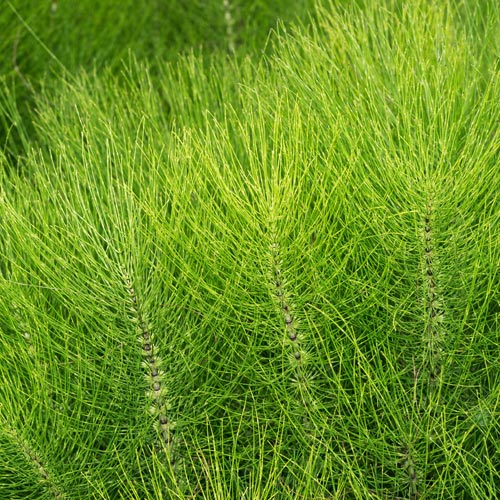Horsetails belong to a class of plants, the Equisetaceae, that has no direct affinity with any other group of British plants. Their closest relations are the ferns. The class includes only a single genus, Equisetum, the name derived from the Latin words equus (a horse) and seta (a bristle), from the peculiar bristly appearance of the jointed stems of the plants, which have also earned them their popular names of Horsetail, Bottle-brush and Paddock-pipes.
Large plants of this order probably formed a great proportion of the vegetation during the carboniferous period, the well-known fossils Calamites being the stems of gigantic fossil Equisetaceae, which in this period attained their maximum development. The Equisetaceae have an external resemblance in habit to Casuarina or Ephedra, and as regards the heads of fructification to Zamia (a genus of Cycadaceae). The Casuarina have the appearance of gigantic Horsetails, being trees with threadlike, jointed, furrowed, pendent branches without leaves, but with small toothed sheaths at the joints. They are most abundant in tropical Australia and less frequently in the Indian Islands, New Caledonia, etc.
The stems spring from a creeping rhizome, or root-stock, which produces at its joints a number of roots. Two kinds of stems are produced fertile and sterile: they are erect, jointed, brittle and grooved, hollow except at the joints and with air-cells in their walls under the grooves. There are no leaves, the joints terminating in toothed sheathes, the teeth corresponding with the ridges and representing leaves. Branches, if present, arise from the sheath bases and are solid. In most cases, the fertile or fruiting stem is unbranched and withers in spring, almost before the barren fronds appear. It bears a terminal cone-like a catkin, consisting of numerous closely-packed peltae, upon the under margins of which are the sporanges, containing microscopic spores, attached to elastic threads, which are coiled round the spore when moist and uncoil when dry.
The development of young Horsetails from the spores is similar to that of Ferns, germination and impregnation being effected in the same manner. The Equisitaceae are also propagated in a vegetative non-sexual manner by means of subterranean stolons and by tubers.
The sterile summer fronds give off numerous, slender, jointed branches in whorls of about a dozen; in some British species, the fruiting and barren stems are often both unbranched. A quantity of silica is deposited in the stems, especially in the epidermis or outer skin. In one species, E. hyemale (Linn.), the epidermis contains so much silica that bunches of the stem have been sold for polishing metal and used to be imported from Holland for the purpose, hence the popular name of Dutch Rushes. It is also called Scouring Rush, and by old writers Shavegrass, and was formerly much used by cabinet-makers. It has also been employed for scouring pewter and wooden kitchen utensils, and thence called Pewterwort.
The Field Horsetail (E. arvense), the species of British Horsetail most commonly met with, is the one now generally used in herbal medicines . It is common in cornfields and wet meadows, its presence can indicate the presence of subterranean water or springs.
In this species, the fruiting stems are simple, very rarely branched, appearing early in spring and soon decaying. The sterile stems which appear later are branched, six to nineteen grooved, the angles rough and sharp, and terminate generally in a long, naked point; the joints are about 25mm long and 3mm in diameter, the teeth of the sheaths long and acute.

